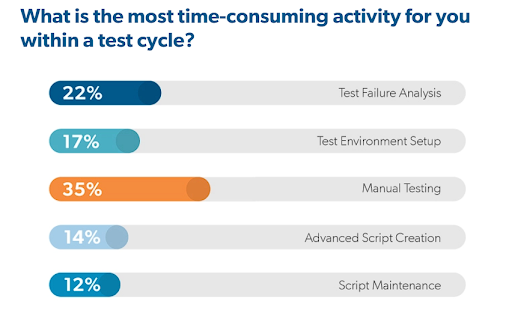
Software testing is like oxygen. If you run out of it, your software will never stand a chance in the market. Imagine walking through a bridge that was not tested. Similarly, Software testing becomes crucial if you don’t want your users to have a bad experience.
But is software testing a challenging affair?
What makes it challenging is the different types of tests that require planning, creation of test modules, and execution on the scale. Test automation helps in overcoming the challenges of software testing.

One of the most significant challenges is manual testing and analysis of test failures. Automation can help you reduce manual testing and failures. Due to testing requirements at scale, organizations need to write tests extensively, leading to errors. Such errors result in failures and further needs analysis. It becomes both time-consuming and costly.
However, like every other solution, test automation also needs optimization to deliver results. So here are some of the best automation techniques for your software development projects.
Here are some tips to follow while selecting a test automation tool.
Top testing automation techniques to ace software development
There are many types of tests: smoke, regression, unit, integration, and user acceptance testing. You need to strategize test automation according to the kind of test and optimize software quality.
Build a test automation framework
Building a testing framework involves four major stages,
- The planning phase includes setting the testing goals, collaborations, and deploying specific testing design patterns.
- The process phase includes streamlining all the testing automation processes across the development activities.
- The performance phase consists of defining metrics that you will measure to track performance.
- Testing automation execution and monitoring key performance parameters to ensure high-quality software delivery.
The best part about a framework is that it streamlines the testing automation for not just one but multiple projects. In other words, you can use the framework for further tests also. Take an example of a non-profit organization looking to develop software for donors and the volunteer community.
There are multiple activities that non-profit organizations need to execute, like, community engagement, accounting, and more. Here software testing automation can help in managing tests and reduce errors.
What is essential to understand is the nature of such activities! For example, accounting software testing is an aspect that can change due to the addition of features or processes.
So, if you have a framework ready to execute test automation for recurring activities, it reduces the time and effort.
Choose the correct design pattern.
Once the framework is ready, design patterns become crucial to ensure that executing test automation provides optimal results. These patterns leverage software engineering automation to implement specific design principles like single responsibility.
- Page objects are automation patterns that model the pieces of software that you want to test. In other words, you just need to create a page object, and the next time you want to make changes to test automation for that specific element, make changes in the page object.
- Screenplay patterns make the page objects more maintainable by breaking them down into small parts. Further, these tests are also easily readable.
- Ports and adaptors allow you to implement the single responsibility principle to test automation where an object or task is for one purpose only. In other words, you can predefine tests for specific software elements.
- The presenter’s first design pattern is a modified version of model-view-controller (MVC) architecture, allowing organizations to use test-driven development approaches. In other words, you can set models and controllers to mimic specific UI behavior for testing purposes.
Once the design pattern and framework are ready, it’s time to choose test automation approaches.
Use the atomic test approach.
Atomic test automation is an approach where each test is a self-contained entity. In other words, it does not depend on predeceasing test results. So, for example, you can use the atomic test approach to separate backend testing and frontend testing.
One of the significant advantages of using an atomic testing approach is the ease of finding an issue when a test fails. Analysis of test failures can take time and prove costly. The atomic test approach reduces the cost of test automation as your analysis requirement is less.
Design the test size for optimal results
Most organizations follow the traditional test pyramid. For example, Martin Fowler shows three main tests in the testing pyramid- unit, service, and UI. However, test size relates to the scale. In other words, you must design the test size for rapid testing.

Test automation does improve the speed of software testing, but if the scale is more significant, it can slow down the process. So, designing the tests faster is crucial for your test automation process.
Make tests readable
Making the tests readable is vital to test automation efficiency. One of the critical aspects of automated testing in software engineering is collaboration. You must understand that the person who creates the test code may be someone other than the one who modifies it. So making test code readable becomes crucial.
Take an example of an Instagram chatbot software. If you want to test an automated live chatbot you need to build different scenarios where it can fail. Here the team that built the code and testing team will be different and so you require readable test codes. Further, testing for failure is an approach that requires specific features and so the choice of testing automation tool becomes crucial.
Choose the right test automation tool.
Choosing suitable automation tools is key to your software development project. It allows you to reduce the cost and time of the testing process. Here are some tips to follow while selecting a test automation tool,
- Use trials or a two-week trial run for proof of concept with all automation tools.
- Check the tool for testing scale and compatible features with your framework.
- Evaluate the cost of test automation tools and calculate the maintenance expenses
- Check the tool for extensibility, testability, and debugging capabilities
- Ensure you have the resources and skilled professionals according to the test automation tool.
Conclusion
Software test automation is more than just a luxury for many organizations. In other words, businesses choose test automation for necessity, not luxury. It provides faster testing, lower risks, and enhanced results. However, if you don’t get the automation right,
it can lead to suboptimal results too. The best way to ensure optimized test automation is to build a framework and use the automation techniques we discussed for better ROI. So, start automating your tests and enhance software delivery.
Interesting Related Article: “Getting Started With Website Test Automation“

